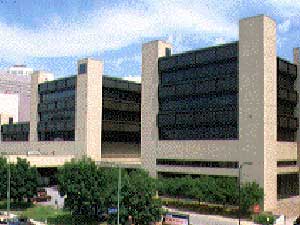|
Photos
More from MPR
Your Voice
|
Cuts in state health care coverage take effect
October 1, 2003
Changes in the state's medical insurance program for low-income Minnesotans took effect Wednesday. The changes mean fewer people are eligible for MinnesotaCare, and those who are eligible will have to pay more. Officials at hospitals such as the Hennepin County Medical Center in Minneapolis say they stand little chance of seeing additional payments from many poor patients.
Minneapolis, Minn. — The state's health insurance program is demanding more from those earning more than $7,000 a year. An adult with no children in that category can expect to chip in more for prescriptions and doctors office visits, higher premium payments, and a $1,000 deductible for hospital admissions. By the state's own count, the changes will force 5,500 people off MinnesotaCare. About 36,000 are currently enrolled.
Hennepin County Medical Center Hospital Administrator Jeff Spartz says, in addition, hospitals will likely have to eat many of the costs not covered by the state. He says that will cost HCMC $13 million next year.
"For self-pay patients, hospitals experience approximately a 10 cent-on-the-dollar collection rate. Most of it will be written off. We'll see more bad debt, and fewer dollars from the state," says Spartz.
Hospitals all over the state are in similar positions. Bruce Rueben, president of the Minnesota Hospital Association, says the state merely shifted the costs to local care providers.
"To suggest that they should pay a significant amount of money out of pocket for care is simply acknowledging that these people are going to end up as charity care patients," he says.
And, Rueben says, that's not just the hospital's problem.
"The hospital will simply have to find a way to make sure that it continues to provide services, regardless of the costs incurred with patients who can't pay. That means those costs have to be spread, at least to some degree, to those who can pay for their care."
Rueben also says when insurance programs are restricted, people tend to delay treatment until their condition worsens, and they ultimately require even more expensive care in the long run.
State Human Services Commissioner Kevin Goodno says he's aware public hospitals will have to fill in some of the gaps.
"On the other hand, there are a lot of people that are in that income category who don't want to be on public assistance, and they have a strong feeling that they need to pay their debts. And even though maybe they can't put a thousand dollars on the table right away, they will be making good on those payments," says Goodno.
By the state's own count, about 5,500 people will lose MinnesotaCare coverage this year, and almost the same number next year. But Goodno says not all of those will be people who are no longer eligible. The program just isn't as good a deal, even for people living on $7,000 a year.
"Most of these cases -- because we're talking about scaling back benefit sets, increasing co-pays, increasing premiums -- it's people that are still eligible for the program, they choose because of the additional premium or co-pays, not to take part in the program," says Goodno.
Health officials and advocates for the poor respond that just because those people don't have coverage doesn't mean they'll get well.
|
News Headlines
|
Related Subjects
|

